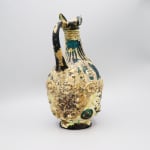Umayyad or Abbasid Glass Ewer , Seventh to Ninth Century AD
Glass
22.2 x 11.5 cm
8 3/4 x 4 1/2 in
8 3/4 x 4 1/2 in
CC.245
Further images
-
(View a larger image of thumbnail 1
)

-
(View a larger image of thumbnail 2
)

-
(View a larger image of thumbnail 3
)

-
(View a larger image of thumbnail 4
)

-
(View a larger image of thumbnail 5
)

-
(View a larger image of thumbnail 6
)

-
(View a larger image of thumbnail 7
)

-
(View a larger image of thumbnail 8
)

-
(View a larger image of thumbnail 9
)

-
(View a larger image of thumbnail 10
)

-
(View a larger image of thumbnail 11
)

In the Qur’an, it states that ‘We [Allah] made everything alive from water’ (sura 21:30). As a result, water, and the vessels which contained it were imbued with a kind...
In the Qur’an, it states that ‘We [Allah] made everything alive from water’ (sura 21:30). As a result, water, and the vessels which contained it were imbued with a kind of spirituality, and ewers of all kinds were afforded elegant shapes and lavish decoration. This spiritual significance underlined the practical significance of water in the hot and arid regions in which Islam emerged. Usually paired with a matching basin, ewers were primarily used for the ritual washing (al-wudu) before prayer (salat). This purification should be carried out by all Muslims regardless of where they are in the world and whatever they are doing, though in the absence of water a ‘dry ablution’ (tayammum), where sand or dust can be substituted instead. To correctly carry out wudu, it is important that water from the correct sources is stored properly, to be kept away from – for example – contact with animals. Since water used in the purification cannot be shared between individuals, it was vital that the pure water remained unsullied by human hands. To simply have a shared trough of water in a mosque or private home would be insufficient. It was therefore important that water could be poured over the hands, from a vessel with a handle so that there was no risk of human contact.
While most Islamic ewers were made from durable materials like bronze and brass, glass was rarely used, though became more frequent over time. Islamic glassmaking sprang from two traditions: the Roman tradition in the western (Mediterranean) portion of the Islamic Empire, and the Sassanid tradition in the east. The same tank furnaces which had been used to produce slabs of glass for export from the Third Century AD continued under the early Islamic, until at least the Eleventh Century AD. As a result, the early glass of the Umayyad and Abbasid Periods were the kinds of blue glass produced using Egyptian natron which had dominated the Roman output. It took until the Tenth Century AD for the Islamic glassmaking revolution, when recipes were overturned in favour of glassmaking based on wood and plant ash. This resulted from the interaction between the Roman and Sassanian traditions, thanks to the unification of east and west under the Muslim domain.
This exceptional glass ewer dates from this earlier period, when glass was still made using the same ancient techniques that had been perfected by the Egyptians and Mesopotamians. It is of the deep blue colour commonly associated with Roman glass. The ewer does represent something of an advancement, however, given the thinness off the walls compared to relatively thicker Roman examples. A slightly everted round base leads to a bulbous belly, the relatively flat walls of which are decorated with roundels. The shoulder and long, slender, neck are both elegantly fluted, leading up to the trefoil spout, which bears the characteristics of a folded leaf. A handle rises from the shoulder to just below the rim. The vessel has an attractive patina, the light colour of which contrasts with the depth of the blue glass.
While most Islamic ewers were made from durable materials like bronze and brass, glass was rarely used, though became more frequent over time. Islamic glassmaking sprang from two traditions: the Roman tradition in the western (Mediterranean) portion of the Islamic Empire, and the Sassanid tradition in the east. The same tank furnaces which had been used to produce slabs of glass for export from the Third Century AD continued under the early Islamic, until at least the Eleventh Century AD. As a result, the early glass of the Umayyad and Abbasid Periods were the kinds of blue glass produced using Egyptian natron which had dominated the Roman output. It took until the Tenth Century AD for the Islamic glassmaking revolution, when recipes were overturned in favour of glassmaking based on wood and plant ash. This resulted from the interaction between the Roman and Sassanian traditions, thanks to the unification of east and west under the Muslim domain.
This exceptional glass ewer dates from this earlier period, when glass was still made using the same ancient techniques that had been perfected by the Egyptians and Mesopotamians. It is of the deep blue colour commonly associated with Roman glass. The ewer does represent something of an advancement, however, given the thinness off the walls compared to relatively thicker Roman examples. A slightly everted round base leads to a bulbous belly, the relatively flat walls of which are decorated with roundels. The shoulder and long, slender, neck are both elegantly fluted, leading up to the trefoil spout, which bears the characteristics of a folded leaf. A handle rises from the shoulder to just below the rim. The vessel has an attractive patina, the light colour of which contrasts with the depth of the blue glass.










